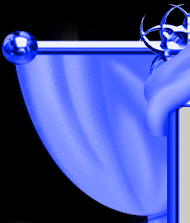Fender Foto Flame Telecasters and Stratocasters
The “Foto Flame” series was a short-lived, inexpensive attempt by Fender to compete with a growing “flame top” market such as PRS and Dean guitars. The “Foto Flame” is an thin piece of photographic film of some very highly figured wood laminated to the guitar, (thus the name Foto), developed by Fender, in connection some photographic corporation. (I have heard both Polaroid and Kodak, but most likely Fuji). The Foto Flame guitars, with the flame on top, usually have a Basswood cap on Alder or, in the case of the Foto Flame being on front and back, the whole body can be made of Basswood. When the “Foto Flame,” film is applied to the Basswood top, it makes the guitar appear as if it had high-end matchbook, figured Maple. The way they shrink wrapped this film around the guitar is amazing and it is hard not to think it is real wood. The Japanese are masters at copying, as these guitars testify. In fact, the Fender USA guys "almost cried" when they saw the MIJ quality as Fender USA was trying to get back up on its feet after the CBS buyout in March of 1984.
The Foto Flame Series was made by Fender Japan through the 1990’s and they stopped production about 1998 (there has been a few 1999 and 2000 Foto Flames floating around in the Japanese markets,so a few were made after the 1998 date.) Many of the Foto Flame models were Reissues of classic Fender guitars. To know more about Foto Flame Reissues and the accuracies of how they were crafted, click here. They always have the “Made in Japan” or “Crafted in Japan” sticker under the finish the heel of the neck by the body, so they do not hide where they are made as do some over-seas companies.
Sometimes they were the brunt of jokes—"want-a-be flame-tops," some said. And then there is the Hambugular conspiracy which says someone who worked at the Fuji Gen Gakki factory actually placed this McDonalds Hambugular's face in the film as a joke! And then he was supposedly fired over it! A myth or a reality? Who knows? But the little faces are there—joke or no joke. One thing is for sure, the quality of these is no joking matter. It is important to reiterate that these MIJ and CIJ Fender guitars were made at the Japanese Fuji Gen Gakki factory, which is the same factory making the $2,000.00 Ibanez guitars. The craftmanship is amazing. As with any guitar, if not set up right, can play like junk. The MIJ and CIJ guitars, with the correct set-up, will rival most USA models and it is said that was one of the reasons Fender moved a plant to mexico and stopped importing the MIJ models. Simply put, they created too much competition with the US models. Hand down, MIJ is much better than MIM (Made in Mexico).
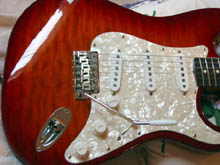 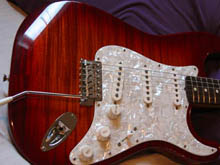
Some of the Foto Flames had a Quilted Maple look (above left) while others had just the Split Flame Maple look (above right). Some come with Foto Flame on the necks. The way this film is wrapped on very authentic looking. Many of the Strats are 62 Reissues (like the 2 above) and many of the Teles are Reissues as well (like 52RI, 69 Thinline RI and others.) If you want to see other Foto Flame models, check out this page: MIJ 96 Ann Tele DX. There are a whole lot of them on that page! Also, some of the Strats came with the Floyd Rose bridge and nut locking systems (which I have always disliked).
This is a Fender 52 Reissue Tobacco Flamed (front and back) 1997 CIJ Tele Foto body and neck with all USA parts. Every aspect of this body is built to the specifications of a 52 Telecaster right down to the routing in the body and the straight edge screws. This Foto model has a Tobacco flame on front AND back with an Alder body. The neck is the 52 chunky V shape made from Maple with the skunk stripe on back. This has a set of Fender Custom Shop 52 RI Pickups with Custom 4-way switching which does the following: Position #1 is the bridge, which delivers that true 52 biting Tele sound. Powerful. Position #2 is the 52 pickups together just like on a regular 52 Tele with that wonderful Tele rhythm sound. Position #3 is the 52 the neck Pickup with the powerful, full rich 52 sound. Position #4 is the neck and bridge pickup in a series, with make both pickups act as a combined humbucker and give a really powerful, full Les Paul sound.
If you want to know more about 1952 Reissues, check out this page!
This is a 1996 MIJ 50th Anniversary Honey Burst 1962 Foto Flame Telecaster Reissue. The Anniversary Sticker is still on the back of the neck. (Serial #U021887) Like the DX Custom Anniversary Teles, these were only made between late 1995 through early 1997. Thus every one you will find has a serial number starting with a T or a U. The neck is solid Maple with a ROSEWOOD fret board with a radius is like a 60’s Teles with the small/medium frets.
Once again all the electronics on this guitar were replaced with USA parts. The pickups are Lace Sensor, which were also used by Fender in their high-end production models from 1988-1998 in what was called the “Plus” series. (Click here to learn more) The NECK pickup is a is a Chrome Model TN-100. It has all the traditional vintage tone and clarity but without the noise. Smooth attack, glassy warmth with full sweet sustain and a thick, fat neck characteristics, with more power. It many ways it has a classic 50's P90 humbucker sound. (Similar to the Blue Lace Sensor pickup) and the BRIDGE pickup is a HIGH OUTPUT T-150 LACE SENSOR. Brilliant clarity, bite and attack running at a hot 12.8k resistance, which is 2 times hotter than your stock Tele pickup. (It is similar to the Red Lace Sensor pickup. To learn more about Lace PUs click here.) The tone control is wired with Fender TBX tone system. It give you more control over the tone as it does not simply bleed off the treble, thus making the guitar muddy sounding.
This is a 1962 Reissue Wine Red 1995 MIJ Stratocaster Foto Flame. (serial #U006438). Completely original except the electronics. Every aspect of this guitar is built to the specifications of a 62 Strat, right down to the routing in the body and the shape of the neck.
The electronics were again converted to all USA parts: The neck pickup is a DiMarzio Virtual Vintage Heavy Blues (DP403) stacked humbucker. This Pickup is louder and fatter than a single coil. It is rich and full and stands out when playing Lead for blues or Jazz. Turn it down and it creates a great rhythm sound. Use distortion and you get a sweet sustain - heavy and powerful! The highs are rounded and really cuts loose when cranked up! The middle and bridge pickups, are Fender 62 USA Reissue Pickups. These give the wonderful traditional historic Strat sound made famous the old 1962 Strats. This Foto-Flame has a Wine Red Foto-Maple finish on a Basswood cap laminated to a Wine Red tinted Alder body. The neck is a really cool Foto-flamed with a mahogany fret board. Because it is a 62RI the finish is a little darker to give it an aged look. The radius is your standard 62 C Shape with medium frets.
This is a NOS Blonde 1996 MIJ 1962 Reissue Telecaster Foto Flame. (serial #T023467). This Foto-Flame is one of my favorite colors and is rarer than the many Wine Red models floating around. The back is once again made from Alder.
The neck pickup is a Seymour Duncan Vintage Rhythm Stack (STK-T1). This rhythm pickup is designed to compliment the tone and output of the Vintage and Hot Stack lead pickups. Specially calibrated for the neck position, it gives you the sound of an early model Telecaster neck pickup all without the noise and hum inherent in single coils.
The bridge pickup is a Seymour Duncan Hot Lead Stack Tapped. (STK-T2 b). By stacking two coils with extra windings around a bar magnet, the output is boosted without altering the pure single coil sound. You get a hotter, brighter sound with more emphasis on the midrange and greater sustain. When "tapped" it has all the bright crispness and bite of the old traditional Tele. This Tele has 4-way switching: Position #4 is the neck; position #3 is the Neck and the Bridge in parallel (standard Tele configuration); position #2 is the Bridge Pickup tapped as a single coil; and position #1 is the Bridge as a stacked single coil with almost double the output of a standard Tele pickup!)
Speaking of Blonde Foto Flames, this is a New Old Stock 1996 Blonde 62 Reissue Strat that I converted to be like a Strat Plus DX. It has the Red, Silver, and Blue Lace Sensor pickups, and the TBX tone control system, just like on the Plus DX modles. This guitar was bought new in 1996, played 2 times and then was put away in the case till I bought it. The original strings were still on it when I received it. A true 62 Reissue as you can find in a very stunning finish! The back is made of an even grained Alder wood. And to think that in Seattle, WA they eat Alder wood smoked fish and chips! LOL! The Foto Flame top sits in nice contrast with the rest of the body.
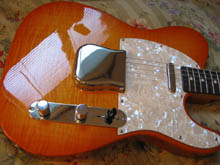 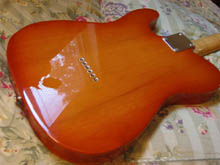 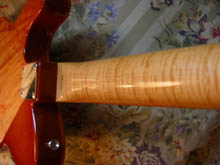
This is a 1995 New Old Stock 1962 Deluxe Foto Flame Telecaster—BRAND NEW. It has a ridiculously low serial number (#T000264). This was found a few months ago in an unopened box in the back of a well know music store in New York. I bought it and tucked it away in my collection. I just peeled off the plastic on the pickguard while customizing it with all new high-end USA electronics a few weeks ago. The color is called an Autumn Burst.
Here is where this guitar gets more interesting: I have improved on Fender’s secret 5-way Jerry Donahue's switching. This Tele is extremely versatile in sound. Unlike a JD Tele, which has a Strat pickup in the neck, this one has a chrome Tele pickup in the neck. Also, the JD Tele’s had a feature that I liked, but wanted to expand upon. Position #5 in the stock JD simply had the neck pickup bypassing the tone control. I felt this was a waste of a switch position! I put in a USA Fender “No-load” tone control so one can still have this feature but now on both the neck and bridge pickups. Want the full screaming power of the pickups with no resistance? You got it! Position #4 is now replaced with the pickups in a series, ile one big spread out humbucker, (instead of the standard parallel wiring) for that “fat” Gisbson-ish sound and position #5 is the neck PU alone. Also there is a special tone taper Capacitor wired into the volume control that prevents the guitar from getting muddy sounding while rolling back the volume.
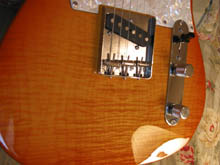 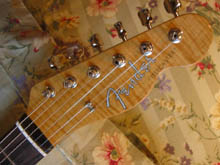 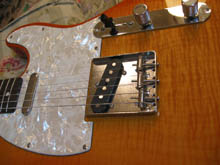
The NECK and BRIDGE pickups are matched Seymour Duncan set (STR-1 and an STL-1) which are exact replicas of the 1954 Fender Telecaster pickups. In 1954, Leo Fender made some changes in the Telecaster lead pickup using smaller diameter magnets. The result was a strong, clear response to high notes, thus creating a bright, biting sound. The STL-1 Neck pickup also duplicates this vintage model in every exacting detail. I have found the sound of these pickups work better that the Strat/Tele Combo on the JD Teles. It creates more range of sound; not so thin in the out-of-phase mode, fat and driven in the series mode, and still retaining that sweet vintage sounds that Telecasters are famous for.
Here is how the switching works: Position 1) The Bridge PU give that vintage Tele bite. Position 2) The Bridge PU and the Neck PU out-of-phase. This gives that unique hollow, honking Strat sound. A really cool JD trick. Position 3) The Bridge PU and the Neck PU in parallel, creating a sweet full Standard Tele rhythm sound. Position 4) The Neck and Bridge pickups in series, which is like creating one large spread-out humbucker! Great for a fat, full, Gibson-ish sound. Want some over drive? You can tell when this kicks in! Position 5) The Neck PU which gives a true-to-life vintage Tele neck sound. Remember at any time you can totally bypass the tone control by simply turning it wide open.
I WILL HAVE GUITARS AND INFO MORE ON HERE IN A LITTLE WHILE
|
